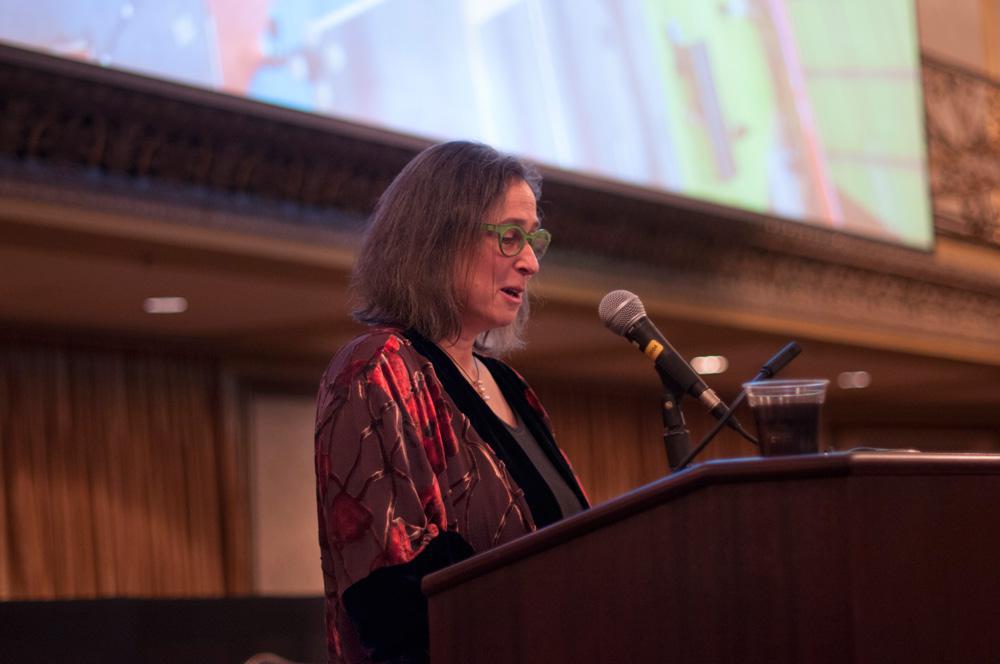“Jewish, secular, American, Canadian, female, child of English professors—these facts provided a frame with blurry edges for my being,” said artist Jessica Stockholder in her recent keynote address at the College Art Association Conference in Chicago. “Any sense of knowing I might have about who I am needed to be flexible.”
As a sculptor and installation artist who grew up in Vancouver, earned a BFA from the University of Victoria, and is now chair of the University of Chicago’s department of visual arts, Stockholder reflected on various identities during her February 12 lecture. Her talk, titled “Knowing, making stuff, things, objects, and 4,198 words,” was as advertised: just under 4,200 words, and it touched on Stockholder’s oscillation between the art world and higher education.
Moving two-and-a-half years ago from what she called her “cottage-industry operation” in Connecticut—where she worked in a space adjoining her house—to a university-based studio in Chicago has made Stockholder feel “a little uneasy,” but creating alongside academic colleagues has its advantages. “I am who I am—valuing the work I make, going about my business alongside physicists, linguists, philosophers, and even English professors,” she said. “I find our presence together, overlapping in the same space, much like the objects in my studio, resonant and meaningful.”
If artists and scholars can play nicely together, as Stockholder described, that isn’t always the case for curators and other arts professionals, including historians, collectors, critics, artists, publishers, and teachers. The CAA program—which attracted more than 4,000 attendees to the conference—bore out those tensions, with panels ranging from “The Delinquent Curator: Has the Curator Failed Contemporary Art?” and “From Academe to Museum: The Academic as Independent Curator” to “The Rise of the Artist-as-Curator” and “The Art Museum Curator: Persevere, Adapt, or Reinvent.”
Several sessions that Suzanne Karr Schmidt, an assistant curator in the Art Institute of Chicago’s prints and drawings department, attended addressed the “ability or lack thereof of museum curators and academics to work together,” and, in the case of specialist curators, “to continue to exist,” she says.
Karr Schmidt, who co-chaired a session at the conference, is always pushing the idea of prints as functional objects, and she has curated exhibits to that effect. “I would like to see an expansion of the idea, taken initially from the history of books, that there is a ‘user’ of artwork, not just a viewer, and that many media feed into each other,” she says.
Since she is so strongly grounded in the love of original art objects, Karr Schmidt says she would only teach directly from them. “I am a bit skeptical of professors who do not engage with [original art objects] in their scholarly writing but then decide to curate exhibitions or apply for museum positions,” she says. “It is not an easier profession, which sometimes seems to be the implication, just a different one with different rhetorical and performance skills, but no less need for due diligence and thorough research.”
Lloyd DeWitt, curator of European art at the Art Gallery of Ontario, saw the big issues at the CAA conference as “technology, the future of art history, [and] humanities under attack and being downsized at institutions all over the world, but especially the U.S. and Europe.” As a self-declared “old-fashioned art history” proponent, he says he would have loved to see more object-focused sessions.
Benefits for curators like him at the conference include networking with colleagues in the academy and getting the lay of the land, says DeWitt, who notes that the scale of the CAA conference has increased “an enormous amount” in recent years. “The anxiety about whether arts and art history have a future on campus grows every year,” he says.
(The fact that no less a figure than President Barack Obama suggested, shortly before the conference, that Americans could probably make more in manufacturing “than they might than [with] an art history degree” might have heightened this anxiety, even if Obama later apologized for the comment.)
Amid the conference’s growth, there has also been an increased focus on the global arts community, says Deepali Dewan, senior curator of South Asian arts and culture at the Royal Ontario Museum, who met attendees from Cairo, Malaysia, and Mumbai. In previous years, she says, CAA was “predominantly a North American community.”
Dewan also noticed “more frequent and meaningful cross-historical conversations” between scholars of pre-modern and contemporary art, who “used to occupy separate intellectual spaces.”
Having attended his fifth CAA conference, Peter Dykhuis, the director and curator at the Dalhousie Art Gallery in Halifax, says he keeps returning to “pursue intellectual trade routes which take me outside of Canada” and to maintain strong American connections. “It is also important, as a Canadian, to not be locked on this side of the 49th Parallel,” he says.
Over the years, Dykhuis has presented in some CAA sessions as a curator at a university gallery and in others as a studio practitioner. “I have always felt that it was OK to be on both sides of the fence in the university system and treat it as research of sorts,” he says, “something that the post-secondary education should be able to accommodate.” Dykhuis believed there were many more sessions on curating this year than there were at last year’s conference.
“Pursuing cultural, critical, and social relevance is the most important focus within the university system,” he adds. “Otherwise, the conference is only about inward-looking, art historical navel gazing for highly paid specialists that are only speaking to each other.”
Menachem Wecker, who is based in Chicago, is the former education reporter at U.S. News & World Report.

 Jessica Stockholder delivers the keynote address at the College Art Association Conference in Chicago on February 12. Photo: Bradley-Marks. Courtesy CAA.
Jessica Stockholder delivers the keynote address at the College Art Association Conference in Chicago on February 12. Photo: Bradley-Marks. Courtesy CAA.







